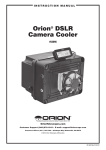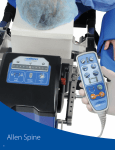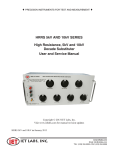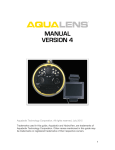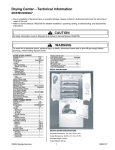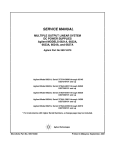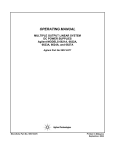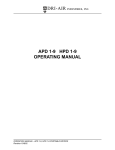Download RV-722 Voltage Divider User and Service Manual
Transcript
♦ PRECISION INSTRUMENTS FOR TEST AND MEASUREMENT ♦ RV-722 Voltage Divider User and Service Manual (formerly manufactured by esi) Copyright © 2009 IET Labs, Inc. Visit www.ietlabs.com for manual revision updates RV-722 im/December 2009 IET LABS, INC. 534 Main Street, Westbury, NY 11590 www.ietlabs.com TEL: (516) 334-5959 • (800) 899-8438 • FAX: (516) 334-5988 ♦ PRECISION INSTRUMENTS FOR TEST AND MEASUREMENT ♦ IET LABS, INC. 534 Main Street, Westbury, NY 11590 www.ietlabs.com TEL: (516) 334-5959 • (800) 899-8438 • FAX: (516) 334-5988 RV-722 NOTICE This manual for the IET Labs Model RV-722 is offered as a convenience. The IET RV-722 is identical in form and function to the original esi Model RV-722. It has been updated in that it employs sealed switches and hermetically sealed stable resistors. The esi unit used fixed resistors that allow factory readjustment only. And, as esi factory service has not been available, the units had to be discarded if out of specifications. The IET unit offers the user the option of readjustment of the resistors to bring the unit into initial specifications. This manual contains the same original esi manual information along with more tutorials and background as well as instructions for the optional adjustment of the resistors. The user may use the original esi manual if preferred. i RV-722 WARRANTY We warrant that this product is free from defects in material and workmanship and, when properly used, will perform in accordance with applicable IET specifi cations. If within one year after original shipment, it is found not to meet this standard, it will be repaired or, at the option of IET, replaced at no charge when returned to IET. Changes in this product not approved by IET or application of voltages or currents greater than those allowed by the specifi cations shall void this warranty. IET shall not be liable for any indirect, special, or consequential damages, even if notice has been given to the possibility of such damages. THIS WARRANTY IS IN LIEU OF ALL OTHER WARRANTIES, EXPRESSED OR IMPLIED, INCLUDING BUT NOT LIMITED TO, ANY IMPLIED WARRANTY OF MERCHANTABILITY OR FITNESS FOR ANY PARTICULAR PURPOSE. ii RV-722 WARNING OBSERVE ALL SAFETY RULES WHEN WORKING WITH HIGH VOLTAGES OR LINE VOLTAGES. Dangerous voltages may be present inside this instrument. Do not open the case Refer servicing to qualified personnel HIGH VOLTAGES MAY BE PRESENT AT THE TERMINALS OF THIS INSTRUMENT WHENEVER HAZARDOUS VOLTAGES (> 45 V) ARE USED, TAKE ALL MEASURES TO AVOID ACCIDENTAL CONTACT WITH ANY LIVE COMPONENTS. USE MAXIMUM INSULATION AND MINIMIZE THE USE OF BARE CONDUCTORS WHEN USING THIS INSTRUMENT. Use extreme caution when working with bare conductors or bus bars. WHEN WORKING WITH HIGH VOLTAGES, POST WARNING SIGNS AND KEEP UNREQUIRED PERSONNEL SAFELY AWAY. CAUTION DO NOT APPLY ANY VOLTAGES OR CURRENTS TO THE TERMINALS OF THIS INSTRUMENT IN EXCESS OF THE MAXIMUM LIMITS INDICATED ON THE FRONT PANEL OR THE OPERATING GUIDE LABEL. iii RV-722 Contents NOTICE.........................................................................................................i Chapter 1: Introduction..............................................................................1 1.1 General Description............................................................................................... 1 1.2 Circuit Description................................................................................................. 2 1.2.1 Circuit Model............................................................................................... 2 1.2.2 Theory of Operation.................................................................................... 4 Chapter 2: Specifications..........................................................................5 Specifications.................................................................................................................. 5 Chapter 3: Installation................................................................................8 3.1 Initial Inspection.................................................................................................... 8 3.2 Installation.............................................................................................................. 8 3.3 Repackaging for Shipment..................................................................................... 8 3.4 Storage................................................................................................................... 8 Chapter 4: Operation..................................................................................9 4.1 Initial Inspection and Setup................................................................................... 9 4.2 General Considerations for Use of a Voltage Divider............................................ 9 4.3 Power Limitations.................................................................................................. 9 4.4 Temperature and Power Effects............................................................................. 10 4.5 Loading Errors....................................................................................................... 10 4.6 Switch Conditioning.............................................................................................. 12 4.7 Operation and Controls.......................................................................................... 12 4.8 Use, Applications, and Calibration of the RV-722................................................. 13 Chapter 5: Decade Adjustment..................................................................14 5.1 Introduction to decade adjustment......................................................................... 14 5.2 Considerations and Overview of Adjustment Procedure of Resistors................... 14 5.2.1 Calibration Switch....................................................................................... 15 5.2.2 Review of Measurement Options................................................................ 15 5.3 Resistor Adjustment Procedure.............................................................................. 16 5.3.1 Adjusting the first three decades.................................................................. 16 Chapter 6: Verification, Calibration, and Maintenance ...........................18 iv Table of Contents RV-722 Figures and Tables Figure 1-1: RV-722 Kelvin-Varley Voltage Divider.........................................1 Figure 1-2: Digital Potentiometer Model for Kelvin-Varley Voltage Divider...2 Figure 1-3: Thévenin Equivalent Circuit of Kelvin-Varley Voltage Divider.....3 Figure 1-4: Output Resistance as a Function of Dial Setting.......................3 Figure 1-5: Schematic Diagram of RV-722 Kelvin-Varley Divider Circuit......4 Figure 2-1: Sample Label Attached to the Instrument..................................7 Figure 4-1: Power Distribution Effect of Interpolating Resistors...................10 Figure 4-2: Thévenin Equivalent Circuit to Show Loading Effects................10 Figure 4-3: Output Resistance as a Function of Dial Setting.......................11 Figure 4-4: Nomogram for Output and Linearity Deviation...........................11 Figure 4-5: RV-722 Front Panel....................................................................12 Figure 5-1: Internal Rear Panel of RV-722...................................................15 Table 5-1: RV-722 Resistance Adjustment Table..........................................16 Figure 5-2: RV-722 PC Board Layout...........................................................17 Table of Contents v RV-722 This page is intentionally left blank. vi Table of Contents RV-722 Chapter 1: Introduction 1.1 General Description The new RV-722 Rev. E (Figure 1-1) is equivalent in form and fit to the esi Model RV-722. It is updated with a number of improved features. The RV-722 is a calibration-grade voltage divider employing the Kelvin-Varley circuit. It is a highly accurate, stable, and linear primary ratio standard suitable for use in many applications requiring known voltage or current ratios. In particular, the RV-722 is especially appropriate for use in bridge circuits, providing two legs of a bridge with a well-known ratio. Figure 1-1: RV-722 Kelvin-Varley Voltage Divider A Kelvin-Varley voltage divider is designed for use in null-balance circuits or as a voltage source for highimpedance circuits. See References. It cannot be used as a simple variable resistor because of the additional resistance in series with the tap; see Figure 1-2. The resistance ratios between the taps of a Kelvin-Varley divider are not linearly related to the voltage ratios. Although many new higher-performance DMM’s (Digital Multimeters) claim to have a voltage divider capability, that capability is limited to one or two decades, and the Kelvin-Varley circuits remains the choice for all precision divider applications to a fraction of a ppm. Introduction The RV-722 has a resolution of 0.1 ppm and an absolute linearity of 0.5 ppm. Long-term linearity is 1.0 ppm, but the unit may be brought into initial specifications with internal adjustments; see Chapter 5. Temperature coefficient of linearity is 0.2 ppm/ºC, and power coefficient of linearity is 1 ppm/W. The RV-722 incorporates a number of advanced features for convenience and high performance. These include: • internal readjustment capability • state-of-the-art very low temperature coefficient hermetically sealed resistors • Kel-F mounted low-emf tellurium copper binding posts • a convenient operating guide attached to the unit • Technical references available on IET’s website The RV-722 features an internal OPERATECALIBRATE switch to allow built-in trimming so that the unit may be adjusted with conventional instruments whenever required to bring it to initial performance specifications. The RV-722 employs sealed precision resistors which have been aged; temperature and power-cycled to maximize long-term stability; and matched to minimize temperature and power coefficients effects. The most significant decades are matched and hermetically sealed to minimize temperature-coefficient effects. 1 RV-722 The switches are made of solid silver-alloy contacts for long life, minimum contact resistance, and no tarnishing. The three most significant decades use sealed switches. The switches have multiple-wiper contacts to provide stable, low contact resistance. High-quality, gold-plated, tellurium-copper binding posts minimize the thermal-emf effects which would artificially reflect a change in dc resistance measurements. They are mounted to the case on special Kel-F washers to assure low leakage. All other conductors within the instrument, as well as the solder employed, contain no metals or junctions that could contribute to thermal emf problems. The front panel is clearly labeled, showing step size for each decade. Maximum voltage and current limits are indicated as well. The unit may be mounted in a standard 19-inch rack. Applications include linearity determination, the measurement of voltage and resistance, and the calibration of other dividers, potentiometers or similar devices involving both voltage and current. 1.2 Circuit Description 1.2.1 Circuit Model A Kelvin-Varley voltage divider may be thought of as being equivalent to a digital potentiometer, except that it has an additional - but variable - resistance in series with the wiper arm. Such a circuit model of the RV-722 may be seen in Figure 1-2. In the case of the RV-722, the resistance between the input terminals 1 and LOW is 100 kΩ. 2 1.0 LOW HIGH LOW Figure 1-2: Digital Potentiometer Model for Kelvin-Varley Voltage Divider An actual digital potentiometer uses decades of resistor steps, each decreasing by a factor of ten. The problem with such a digital potentiometer, however, is that its resolution becomes limited by the ever-smaller resistor valus. They become difficult to implement as the contact resistance of switches and connections become significant. A Kelvin-Varley circuit overcomes this problem with its special design, described later. Another way to model the RV-722 is with the Thévenin equivalent circuit shown in Figure 1-3, where S is the dial setting. Note that if the output is being fed into a very high impedance, then the output impedance RO, may be ignored. In general, however, the effect of load impedance, RL must be taken into consideration, as will be discussed below. The approximate value of RO is shown in Figure 1-4. It may be seen that the output impedance is maximum at about the dial setting of 0.5 and drops to zero at both ends (1.0 and 0.) It is the value of RO which will influence the effect of loading. Note, however, that in general bridge applications, nominally zero current flows out of the divider as the bridge comes into balance, and therefore the divider effectively “sees” an infinite impedance, and the effect due to Ro may be safely ignored. Introduction RV-722 RO SVIN VOUT RL Figure 1-3: Thévenin Equivalent Circuit of Kelvin-Varley Voltage Divider Figure 1-4: Output Resistance as a Function of Dial Setting Introduction 3 RV-722 1.2.2 Theory of Operation The actual circuit diagram of the RV-722 is shown in Figure 1-5. This circuit is capable of dividing the input into 107 parts, i.e. 0.1 ppm. It consists of seven decades, each of which divides its input voltage into 10 equal parts. The implementation of this division may be seen as follows: The input voltage across each decade is divided by 10 equal resistances. Placing the resistance of the succeeding interpolating decade in parallel with a portion of the upstream decade reduces the effective resistance of that portion. In particular, examine the figure and note that first decade has 11 (not 10) resistors. The divider wipers from the second decade encompass two resistors totaling 20 kΩ. This 20 kΩ is shunted by 20 kΩ, the effective total resistance of the interpolating second decade (it is convenient to think of the second decade, as with all other decades, as 10 resistors) of 10 x 2 kΩ, or 20 kΩ with all the shunting in parallel with it, resulting in a total effective resistance of 10 kΩ for that step. The 11 steps become equivalent to 10 steps of 10 kΩ each, and in this way all the steps are kept equal. Each step of the second decade is 2 kΩ. The 4 kΩ of that decade, spanned by the switch contacts, are shunted by the 4 kΩ effective resistance of the third decade. Similarly 800 Ω of the third decade are shunted by the 800 Ω total resistance of the fourth decade. Note that this pattern reduces the resistor value until an final value of 400 Ω is reached and repeated. This allows the use of a resistance high enough to avoid contact resistance problems. Note that the last decade uses only one switch wiper and can therefore span positions 0-10. With all significant decades set to 9, and the last one set to 10, the output is 1.0 or equal to the input. At the low or zero end, a small series resistance is added between the OUTPUT LOW terminal, the lower end of the divider string, and the INPUT LOW terminal to compensate for contact and wiring resistance, thus bringing the voltage at the OUTPUT LOW terminal equal to the voltage at the OUTPUT HIGH terminal for all switches set to 0. This provides improved performance for low voltage outputs. Figure 1-5: Schematic Diagram of RV-722 Kelvin-Varley Divider Circuit 4 Introduction RV-722 Chapter 2: Specifications For convenience to the user, the pertinent specifications are given in an OPERATING GUIDE, shown in Figure 2-1, affixed to the case of the instrument. Specifications Definitions: Linearity is the expression of the accuracy of the divider in proportional parts of input. Two types of linearity are frequently specified: absolute and terminal. Absolute linearity is the accuracy relative to the output at the end-scale settings of 0 and 1.0 That is, the divider is defined as correct at these settings. Terminal Linearity is the accuracy relative to the input at the divider end terminals. The RV-722 has separate input and output common terminals, so that the output common may be compensated for small voltage drops in leads and switches, making the output zero when the setting is zero. Overview: Two separate terminal-linearity specifications are given: Absolute - relative to the output common terminal, and Terminal Linearity relative to the input common terminal. Mid-scale linearity and coefficient ratings apply for settings between 0.1 and 0.9. The ratings will typically improve below 0.1 in proportion to the square root of the setting, and above 0.9 in proportion to the square root of 1 minus the setting. Absolute Linearity: At 23ºC, at low power; defined relative to zero and full scale outputs, at the output terminals. Quantitatively it is [Vout/ Vin] - S, where S is the dial setting, that is the divider is defined as correct at these end settings. See definition above. Initial: ±0.5 ppm at midscale, improving to zero at end settings Long-Term: ±1 ppm at midscale, improving to zero at end settings Certificate-Corrected: ±0.2 ppm at midscale, improving to zero at end settings Terminal Linearity (Relative to Input Terminals): The accuracy at the divider end terminals, relative to the input. See definition above Same as absolute linearity except for <0.05 ppm end voltage drop. Temperature Coefficient of Linearity: ±0.2 ppm/oC at midscale, improving to zero at end settings. Power Coefficient of Linearity: ±1 ppm/W at midscale, improving to zero at end settings. Switch Contact and Wiring Resistance Variations: Initial: ±0.004 ppm Long-Term: ±0.008 ppm Calibration conditions: 23°C, low input power. Specifications 5 RV-722 Number of Decades: Seven Resolution: 0.1 ppm Input Resistance: 100 kΩ ±50 ppm Maximum Output Power: 2.5 W continuous, 5 W intermittent Maximum Input Voltage: 700 Vrms. Breakdown Voltage: 1000 V peak to case. 6 Terminals: High-quality low-thermal-emf, gold-plated, tellurium-copper binding posts; standard 0.75” spacing; additional binding posts are connected to the case for shielding. Terminals are insulated from the case by non-moistureabsorbing Kel-F spacers. Dimensions: 48.25 cm W x 13.3 cm H 21.3 cm D (19.0” x 5.25” x 8.4”) Weight: 5.6 kg (12.5 lb) Specifications Specifications ABSOLUTE LINEARITY: DESCRIPTION: LOW esi/Tegam formerly manufactured by 1000 V, peak to case. BREAKDOWN VOLTAGE: MODEL: RV-722 SN: 621001 www.ietlabs.com • 534 Main Street, Westbury, NY 11590 • (516) 334-5959 • (800) 899-8438 • Fax (516) 334-5988 /KVD600 LBL/esi RV 722 RevE/p3/77%/12-09 Whenever the unit has been idle, turn each switch 7-10 times both ways before using. This switch "break-in" procedure is standard metrology practice required for best accuracy to remove any silver oxide film on the contact surfaces, typically <1 mΩ. Observe all safety rules when working with high voltages or line voltages. Connect the (GND) terminals to earth ground in order to maintain the case at a safe voltage. Whenever hazardous voltages (>45 V) are used, take all measures to avoid accidental contact with any live components: a) Use maximum insulation and minimize the use of bare conductors, b) remove power when adjusting switches, c) post warning signs and keep personnel safely away. WARNING EFFECT OF CONTACT AND WIRING RESISTANCE VARIATION ON LINEARITY: ±.004 ppm initial, ±.008 long term. 700 Vrms. MAXIMUM INPUT VOLTAGE: 23°C at low power. TEST CONDITIONS: Connected to case. Zero error at OUTPUT LOW terminal < ±0.002 ppm of input; Zero error at INPUT LOW terminal < ±0.05 ppm of input; Full scale error at OUTPUT HIGH terminal < ±0.05 ppm of input; typical values. END ERRORS: SWITCH OPERATION: 2.5 W continuous, 5 W intermittent. MAXIMUM INPUT POWER: GND TERMINALS: 100 kΩ ±50 ppm. INPUT RESISTANCE: Figure 2-1: Sample Label Attached to the Instrument Linearity deviation, the error between the actual output voltage (VOUT) and the ideal output voltage for a particular setting, (S): Linearity Deviation=[VOUT /VIN] - S Initial: ±0.5 ppm at mid-scale, improving to zero at end settings. Long-Term: ±1 ppm at mid-scale, improving to zero at end settings. Accuracy may be restored to initial specfications with internal adjustments. LOW ±1 ppm of input/W at mid-scale, improving to zero at end settings. POWER COEFFICIENT of LINEARITY: Decade voltage divider employing the Kelvin-Varley circuit, TERMINAL LINEARITY: (Relative to Input Terminals): same as providing known voltage and current ratios for calibration, absolute linearity except for end voltage bridges, linearity determination, and other applications. drops not exceeding 0.05 ppm. Note: A Kelvin-Varley divider is not the exact equivalent of a 0.1 ppm in 7 decades. potentiometer, but has an additional variable resistance in RESOLUTION: series with the wiper, ranging between zero and about 66 kΩ. TEMPERATURE COEFFICIENT ±0.2 ppm of input/°C, at mid-scale improving HIGH 1.0 of LINEARITY: to zero at end settings. CONSULT INSTRUCTION MANUAL FOR PROPER INSTRUMENT OPERATION RV 722 KELVIN-VARLEY VOLTAGE DIVIDER OPERATING GUIDE RV-722 7 RV-722 Chapter 3: Installation 3.1 Initial Inspection 3.3 Repackaging for Shipment IET instruments receive a careful mechanical and electrical inspection before shipment. Upon receipt, verify that the contents are intact and as ordered. The instrument should then be given a visual and operational inspection. If the instrument is to be returned to IET Labs, contact the Service Department at the number or address, shown on the front cover of this manual, to obtain a “Returned Material Authorization” (RMA) number and any special shipping instructions or assistance. Proceed as follows: 1. Attach a tag to the instrument identifying the owner and indicate the service or repair to be accomplished. Include the model number, the full serial number of the instrument, the RMA number, and shipping address. 2. Wrap the instrument in heavy paper or plastic. 3. Protect the front panel and any other protrusions with cardboard or foam padding. 4. Place instrument in original container or equally substantial heavy carton. 5. Use at least 3 inches of packing material around all sides of instrument. 6. Seal box with strong tape or strapping. 7. Mark shipping container “DELICATE INSTRUMENT,” “FRAGILE,” etc. If any shipping damage is found, contact the carrier and IET Labs. If any operational problems are encountered, contact IET Labs and refer to the warranty at the beginning of this manual. Save all original packing material for convenience in case shipping of the instrument should become necessary. 3.2 Installation For a rack-mounted model, installation in a 19 inch rack may be made using the slots in the rack mounting ears. A mounting location that does not expose the unit to excessive heat or temperature variations is recommended. It may be necessary to remove the stick-on feet on the bottom of the unit it they interfere mechanically with placement. For bench models, no installation as such is required, because this instrument series is not powered. Since the RV-722 is a high-accuracy instrument, it is recommended that a bench space be provided that would not expose it to abuse and keep it protected from temperature extremes and contaminants. 8 3.4 Storage If this instrument is to be stored for a lengthy period of time, it should be sealed in plastic and stored in a dry location. It should not be subjected to temperature extremes. Extended exposure to such temperatures can result in an irreversible change in resistance, and require recalibration. Installation RV-722 Chapter 4: Operation 4.1 Initial Inspection and Setup This instrument was carefully inspected before shipment. It should be in proper electrical and mechanical order upon receipt. An OPERATING GUIDE, like the typical one shown in Figure 2-1, is attached to the case of the instrument to provide ready reference to specifications. 4.2 General Considerations for Use of a Voltage Divider A Kelvin-Varley voltage divider is designed for use in a null-balance circuits or a voltage source for high impedance circuits; See appendix. It cannot be used as simple variable resistor because of the additional resistance in series with the tap; see Figure 1-2. The resistance ratios between the taps of a Kelvin-Varley divider are not linearly related to the voltage ratios. 4.3 Power Limitations CAUTION Excessive current can damage the instrument. To avoid damaging the RV-722, it is necessary to take certain precautions. The input voltage limitation of 700 V will normally protect the instrument from excessive power dissipation. However, with certain dial settings and connections, it is possible to draw excessive current and permanently damage the instrument if the input voltage is maintained. For this reason, the source should be limited to 1 W if possible. This can be done by inserting a resistor with a value R=E2/4 in series with the supply voltage E. Another method of protecting the divider is to fuse the output with a 10 mA fuse. Although many new high-performance DMM’s (Digital Multimeters) claim to have a divider capability, that capability is limited to one or two decades, and a Kelvin-Varley voltage divider such as the RV-722 remains the choice for all precision divider applications requiring a fraction of a ppm. Operation 9 RV-722 4.4 Temperature and Power Effects Figure 4-1 illustrates the division of current and power in the RV-722 resistors. The temperature rise in each resistor is almost directly proportional to the power applied to it. Figure 4-2: Thévenin Equivalent Circuit of a KelvinVarley Voltage Divider to Show Loading Effects It may be seen that it is the relative size of the term RO/RL to the linearity deviation that determines the Importance of the loading error. In particular, for the RV-722, RL must be greater than 1 TΩ, i.e. 1012, for the loading effect to be <.03 ppm for the maximum RO. It will be smaller for lower output resistances at other settings. Figure 4-1: Power Distribution Effect of Interpolating Resistors Uneven power distribution results from the shunting of two of the eleven resistors in each decade by the next decade (refer to Figure 1-5). As a result of this uneven power distribution, the shunted resistors do not get as hot as the rest. Therefore, if the divider is to be run at fairly high power and the first decade is switched, a short time should be allowed for the redistribution of heat in the resistors. 4.5 Loading Errors As may be seen from Figure 4-2, the output voltage of an unloaded Kelvin-Varley divider is given by: VOUT = SVIN + DEV where DEV is the fractional linearity deviation. When a load is applied, the output becomes: VOUT = SVIN + DEV - RO/RL where RO is the output resistance which may be determined by shorting the input leads and measuring across the output leads, or can be approximated by using Figure 1-4. RO ranges from zero to about 66 kΩ. RL is the load resistance applied at the output. 10 A bridge circuit under balanced conditions will effectively draw no current from the RV-722 and approach a true open circuit. When a load is placed across the output of the RV-722, the output voltage will change. This change in output voltage may or may not have to be considered in the measurement being made, depending on the degree of accuracy desired. With high impedance loads the effect of the load may be less than the effect of the linearity deviation. In this case the change in output voltage due to output loading can be neglected. The RV-722 can be represented by an equivalent generator and output resistor in series, as shown in Figure 4-2. With this equivalent circuit and a known load resistance, the effect on output voltage can be easily analyzed. Variations in output voltage can be expressed as LINEARITY DEVIATION (deviation from nominal output in proportional parts of the input), or as OUTPUT DEVIATION (the deviation from nominal output in proportional’ parts of the output). Operation RV-722 Figure 4-3 is a plot of the output resistance of the RV-722 as a function of its dial setting. The resistance values are symmetrical about a setting of .500,000,0. For example, the output resistance at a setting of .985,000,0 will be the same as that for a setting of .015,000,0. The resistance corresponding to .255,555,5 can be found in Figure 4-4. With the Kelvin- Varley circuit the maximum output resistance occurs at settings of .455,555,5 and .544,444,4. The output resistance measurements are made by shorting the input terminals together and measuring the resistance across the output terminals. Figure 4-3: Output Resistance as a Function of Dial Setting Figure 4-4: Nomogram for Output Deviation and Linearity Deviation Due to Output Loading Operation 11 RV-722 4.6 Switch Conditioning The main switch wipers employed in this unit are self-cleaning, and are constructed of solid silver alloy with solid silver alloy contacts. Whenever left idle, all the wipers and contacts should still be conditioned or “re-broken-in” to remove any oxide that develops over time. This is standard metrology practice when high accuracy is required. This effect is of the order of less than 1 mΩ, so it may be ignored whenever measurements of that magnitude are not important. To perform this “breaking in,” simply rotate each switch seven to ten times in each direction. should be exercised since most often such connectors are usually made of brass, which can add thermal emf. Copper or copper alloy connections should be used, or bare wire which is tinned copper may be employed. Similar connections are made to the OUTPUT terminals. CAUTION Do not handle Kel-F washers with bare hands to maintain low leakage. Implement any current limiting protection as described in the power considerations discussion of section 4.3. 4.7 Operation and Controls WARNING Observe all safety precautions if high voltages are used. Figure 4-5 shows the front panel and the various controls and connection terminals of the RV-722 divider. The dials may be set and read directly on the front panel. Some decades have blank positions to be used only in the calibration mode. The least significant decade has a “10” setting which can be used to provide an output of 1.0, i.e. 100% of the input. End errors should be considered in any application. Either the specified values should be used or the end errors may measured as described in the Verification, Calibration and Maintenance section below. The input voltage is connected to the 1.0 INPUT. Secure connections should be made to the terminals using spade lugs, banana plugs, or bare wire. Caution Figure 4-5: RV-722 Front Panel 12 Operation RV-722 4.8 Use, Applications, and Calibration of the RV-722 There is a broad spectrum of applications for a KelvinVarley divider, such as calibrating other voltage dividers, measuring unknown voltages, and measuring unknown resistances. The best source of information on the use, applications and calibration of the RV-722 are found in the following references: • Calibration of a Kelvin-Varley Standard Divider -- M. L. Morgan and J. C. Riley • Kelvin-Varley Resistive Voltage Divider -- esi Instruction Manual • D C a n d L o w F re q u e n c y A C R a t i o Measurements -- Engineering Bulletin No. 29 • Calibration of a Kelvin Varley Voltage Divider -- Engineering Bulletin No. 24 • A Resistance Bridge Made From a Voltage Divider -- Engineering Bulletin No. 38 All these references are available on IET’s website. Consult IET Labs for assistance and additional information. Operation 13 RV-722 Chapter 5: Decade Adjustment This chapter describes an additional option of the IET RV-722 -- to adjust the resistors in order to bring them into initial specifications. This option was not available in the esi RV-722. Therefore, this process is OPTIONAL. 5.1 Introduction to decade adjustment It is important to make a distinction between calibration and adjustment. Calibration is the “official” sometimes “accredited” - measurement of a value or a parameter; as commonly used, “calibration” is incorrectly applied to the setting of a parameter, e.g with a potentiometer. Adjustment is the proper term for “setting.” This chapter will deal with the adjustments required to bring the RV-722 into specifications As may be seen from the schematic of a Kelvin-Varley voltage divider shown in Figure 1-5, the linearity depends primarily on the equivalence of the resistance steps. Other sources of error are leakage and switch contact resistance stability. 5.2 Considerations and Overview of Adjustment Procedure of Resistors The goal of this procedure is to adjust the value of the resistors in the first three decades to be: • matched to each other within each decade • linear with each other from decade to decade • accurate to their absolute value Clearly the third requirement, if met completely, would be sufficient, but it is important to understand that the matching of the individual values becomes important since the true absolute value cannot be practically achieved. The user has the ability to measure the leakage of the unit and take action if required. The switch contact resistance is known to remain high for decades. The new IET RV-722 allows user adjustment of the resistance values of the first three decades. Adjustable trimmers in the first three decades allow setting the various resistances with respect to each other or to some resistance standard. This can compensate for the effects of aging and temperature, and makes it possible to adjust the unit to initial specifications whenever desired. If an accredited calibration is required, the unit may be returned to IET labs. 14 Decade Adjustment RV-722 5.2.1 Calibration Switch In order to be able to calibrate the resistors individually, they must be electrically independent from other decades. This is accomplished by the use of the internal CALIBRATE-OPERATE switch. This switch, inside the unit, is normally set to the OPERATE position. For adjustment of the resistors, set the switch to the CALIBRATE position which electrically separates the resistors of the first three decades Access to each resistor is now possible on the Adjustment PC board inside the unit. 5.2.2 Review of Measurement Options As discussed above, what is required is the capability to measure and adjust and match the resistances of 10,000 Ω of the first decade steps at: • Accuracy: 4 ppm • Resolution: 0.1 ppm • Repeatability: 2 ppm • Matching: 1 ppm This is the requirement of the first decade, which is the most exacting. The requirements for the second and third decades are less exacting. The assumption here is that the user has the capability and the equipment required to perform this measurement. Therefore, it is up to the user to make these adjustments and measurements in a proper metrological fashion. IET Labs is available for assistance. There are a number of instrumentation options for accomplishing this. These include , but are not limited to: • High-performance DMM’s such as Fluke Model 8508A This may be used in the ratio mode with a resistance standard attached to the rear of the meter, or in the direct measurement mode. • • Resistance bridges such as the MI 6000 Series, the Guildline 6622A Series, The IET (formerly esi) Model 242, along with resistance standards A bridge measurement system such as described in the performance verification of this manual used in a resistance measurement mode along with an IET Labs (formerly esi) Transfer Standard Series 1010. The significant advantage of the procedure here is that it is self-consistent in the sense that the first resistor is measured, and the second and all subsequent resistors are set to match the first. This produces the required linearity performance without having to attempt to set all the resistors to an absolute “perfect” value. Figure 5-1: Internal Rear Panel of RV-722 Showing Calibrate-Operate Switch Decade Adjustment 15 RV-722 5.3 Resistor Adjustment Procedure 5.3.1 Adjusting the first three decades Before starting the adjustment procedure, allow the RV-722 unit to stabilize at 23°C for at least 24 hours. To set up the unit for adjustments, do the following: 1. Review section 5.2.2. 2. Set up the necessary measurement equipment. 3. Unscrew the screws on the top, rear and bottom of the unit and remove the housing. 4. Set the CALIBRATE-OPERATE switch to CALIBRATE. Setting Requirements Decade 10-1 Decade 10-2 Decade 10-3 Accuracy: 4 ppm Resolution: 0.1 ppm Repeatability: 2 ppm Matching: 1 ppm There are 11 resistors in each of the first three decades. To measure and adjust these resistors, refer to Table 5-1 and Figure 5-2 and do the following: 1. Measure the value of each resistor by connecting to the points indicated in the Measure Across column. 2. As necessary, adjust potentiometers identified in the Adjust column to values specified in the Target column. 3. After completing the adjustments, remeasure to confirm stable settings. 4. Once all resistors are within specifications, set the CALIBRATE-OPERATE switch to OPERATE. 5. Slide the housing back onto the unit and screw all the screws back into their original positions. Measure across Adjust Target J0A-J1A R0A J1A-J2A through J10A-J11A R1A through R10A 10 kΩ less 6 ppm J0B-J1B through J10B-J11B R1B through R10B 2 kΩ J0C-J1C through J10C-J11C R1C through R10C 400 Ω - 60 mΩ (399.94 Ω) 10 kΩ less 6.7 ppm Table 5-1: RV-722 Resistance Adjustment Table 16 Decade Adjustment Figure 5-2: RV-722 PC Board Layout RV-722 Decade Adjustment 17 RV-722 Chapter 6: Verification, Calibration, and Maintenance The following pages are reproduced directly from esi RV-722 manual. 18 Verification, Calibration, and Maintenance RV-722 Verification, Calibration, and Maintenance 19 RV-722 20 Verification, Calibration, and Maintenance RV-722 Verification, Calibration, and Maintenance 21 RV-722 22 Verification, Calibration, and Maintenance RV-722 Verification, Calibration, and Maintenance 23

































